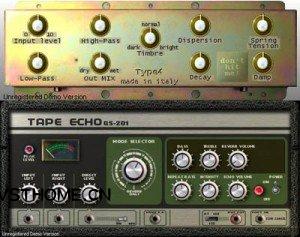Team DYNAMiCS | 01/26/2009 | 5.32 MB
英文简介:
A spring reverb is a system to obtain artificial reverberation invented during the 40's by Laurens Hammond (also inventor of the Hammond Organ). In a Spring Reverb pan, the audio signal is coupled to one end of the spring by a transducer (a device that can convert electrical energy into mechanical energy or viceversa). This creates waves that propagate through the spring in both directions. At the other end of the spring there is another transducer that converts the motion in the spring into an electrical signal, which is then amplified and added to the dry sound. Most spring reverb units use several springs together, with each spring having its own characteristics (length, dimensions, tension, etc.) resulting in a natural reverberation by summing several delayed sounds at fixed or random intervals. However, with real spring reverbs the user isn't allowed to change these characteristics. A software simulation like Type4, on the other hand, allows you to adjust parameters like "decay" (reverb duration), the dampening factor, the virtual spring tension and other parameters that affect the overall timbre of the reverb effect. Why should you want to use a spring reverb rather than a precise and modern digital reverb? Spring reverbs have typical sonic characteristics that, nowadays, make them desirable mostly as effects on their own rather than simulations of an acoustic phenomena.
Plugin Description:
Type4 is a simulation of a vintage "Type4" spring reverb unit.
Main features:
- Four virtual springs with variable tension
- Variable decay length
- Variable dampening factor
- Adjustable pre and post filtering
- Adjustable timbre
- Very low memory and CPU power needed
- Easy MIDI-Learn feature
官网: http://www.genuinesoundware.com/?a=showproduct&b=28

![Applied Acoustics Systems Swatches v1.6.3 Win Mac [FREE]](https://audioz.download/uploads/posts/2024-10/thumbs/1727757539_3762119555.webp)
![Sonosaurus PaulXStretch v1.6.0 Win Mac [FREE]](https://audioz.download/uploads/posts/2024-10/thumbs/1727748542_929935523.webp)
![Auburn Sounds Graillon (Live Voice Changer) v3.0 Free Edition VST VST3 AU AAX LV2 LiNUX WiN MAC [FREE]](https://audioz.download/uploads/posts/2024-10/1727801438_2687997853.webp)
![Chris Liepe Vocal Menace (All-In-One Vocal Effects Processing Plugin) v1.1 x64 x86 VST VST3 AU AAX WiN MAC [FREE]](https://audioz.download/uploads/posts/2024-10/thumbs/1727800952_3858307255.webp)


评论0